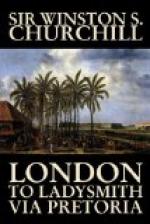I have seen and heard a good deal of what has passed here. I have often been blamed for the freedom with which I have written of other operations and criticised their commanders. I respectfully submit that I am as venomous an amateur strategist as exists at this time. It is very easy—and much more easy than profitable—when freed from all responsibility to make daring suggestions and express decided opinions. I assert that I would not hesitate to criticise mercilessly if I was not myself sobered by the full appreciation of the extraordinary difficulties which the relief of Ladysmith presents; and if there be anyone who has any confidence in my desire to write the truth I appeal to him to be patient and calm, to recognise that perhaps the task before Sir Redvers Buller and his subordinates is an actual impossibility, that if these generals are not capable men—among the best that our times produce—it is difficult to know where and how others may be obtained, and finally to brutally face the fact that Sir George White and his heroic garrison may be forced to become the prisoners of the Boers, remembering always that nothing that happens, either victory or defeat, in northern Natal can affect the ultimate result of the war. In a word, let no one despair of the Empire because a few thousand soldiers are killed, wounded, or captured Now for the story as plainly and briefly as possible.
When Buller had arrived at Potgieter’s he found himself confronted by a horseshoe position of great strength, enclosing and closing the debouches from the ford where he had secured a practical bridgehead. He therefore masked Potgieter’s with seven battalions and twenty-four guns, and sent Warren with twelve battalions and thirty-six guns to turn the right, which rested on the lofty hill—almost mountain—of Spion Kop. The Boers, to meet this turning movement, extended their line westwards along the heights of the Tugela valley almost as far as Acton Homes. Their whole position was, therefore, shaped like a note of interrogation laid on its side, —/\, the curve in front of General Lyttelton, the straight line before Sir Charles Warren. At the angle formed by the junction of the curve and the line stands Spion Kop—’look-out hill.’ The curved position in front of General Lyttelton has been already described in a previous letter. The straight position in front of Sir Charles Warren ran in two lines along the edge and crest of a plateau which rises steeply two miles from the river, but is approachable by numerous long aretes and dongas. These letters have completed the chronicle down to the evening of the 18th, when the successful cavalry action was fought on the extreme left.




